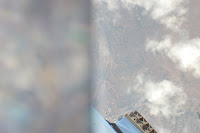For some reason this is the last image we obtained from Hyper-GeoCam. The balloon was only about 1 km up.
Wednesday, September 12, 2007
Double Bummer, Hyper-GeoCam worked only for 20 minutes
Posted by
Igor
at
4:00 PM
1 comments
![]()
![]()
Labels: flight, hypergeocam, launch
Tuesday, September 11, 2007
Bummer, GeoCam is out !
The mud did not do it. It looks like the mechanical finger did not work as intended and we have only one photo of the flight: the tarmac.
The file listing on the SD card clearly shows that on July 27th, at integration, the mechanism for shotting the camera was working but that the day before the launch and the launch day, whenever GeoCam would be activated it would take only one picture. Bummer.
We are looking at Hyper-GeoCam now. The 16 GB card is so large that when looking at the file directory through the USB 1.1 connector we cannot see the .RAW images until the camera downloads all of them which takes a certain amount of time. Initially we were thinking that camera had not taken any shots.
Posted by
Igor
at
4:10 PM
0
comments
![]()
![]()
Labels: geocam, hypergeocam
Ouch, GeoCam fell into the mud


As noted by the HASP folks, one of our payload fell into the mud. We just got the cameras this morning and found out it was GeoCam. Hyper-GeoCam is fine. Now we need to open the boxes and find out if there is anything in either of them....
Posted by
Igor
at
9:41 AM
0
comments
![]()
![]()
Landing in the Mud
September 4, 2007: HASP 2007 RECOVERY SUCCESSFUL: HASP was successfully
recovery from a freshly irregated farm field near Poston, AZ during the morning of September 3. In the words of one of the CSBF managers, "You had a very soft landing!" The recovery crew returned HASP to Ft. Sumner by late afternoon of September 4, where we had a first look at the landing damage. Almost all of the student payloads appeared to have suffered very little injury during landing and recovery. The recovery crew removed most of the small payloads from the fiberglass extension booms and dismounted the UAH, MSU and ULL large payload prior to dragging HASP out of the field. They even managed to fish out from the mud one of the TAMU cameras that had broken off during landing. The HASP electronics system appeared very clean with no obvious evidence of water damage or extensive mud intrusion into the interior. Once HASP is returned to LSU next week, we will be able to do a more through assessment.
Images of the Recovery can be found here
[http://laspace.lsu.edu/hasp/images/2006-2007/09-04-07 ]
Monday, September 03, 2007
College Station, HASP has landed.
From the HASP website:
CURRENT HASP STATUS 08:15 UTC September 3, 2007:
The HASP flight was terminated at 1:52 am today (7:52 UTC)
near Poston, AZ (near the California border). The flight
had 14 hours and 22 minutes of float and lasted close to
19 hours.
Posted by
Igor
at
1:43 AM
0
comments
![]()
![]()
Sunday, September 02, 2007
It's up
Greg Guzik said:
HASP was launched this morning at 7:12 am Mountain time (13:12 UTC). The launch was almost perfect and the payload is working well. Currently, HASP is approaching 30,000 feet altitude.
Posted by
Igor
at
10:27 AM
0
comments
![]()
![]()
Ready to launch
From Greg Guzik:
HASP is now in the pickup process and we should be heading out to the launch pad shortly. No thunderstorms in the area and the winds are looking very good. We anticipate a launch sometime around 7:00 am Mountain time.
Fingers crossed.
Posted by
Igor
at
3:11 AM
0
comments
![]()
![]()
Saturday, September 01, 2007
Maybe tomorrow ?
Greg just sent this:
The HASP launch has been scrubbed for today. The low altitude wind profile remained unacceptable with winds exceeding 10 knots. On the positive side the next two days are launch opportunities. Thus, we will begin this show again at 3:00 am tomorrow Sunday, September 2.
Posted by
Igor
at
7:41 AM
0
comments
![]()
![]()
Labels: hasp, launch, launch preparation
HASP2007 launch today ?
HASP will make a launch attempt tomorrow, Saturday September 1, 2007. The anticipate launch time is 7:30 am Mountain time (i.e. 13:30 UTC), but this could be earlier or later depending upon weather and readiness. The HASP team will arrive at the flight line at about 2:30 am and pickup is scheduled for about 3:30 am. Attached here is our working pre-launch timeline. This will give you an idea of what should be happening at what time. The real times for these events will very likely not correspond exactly with the times listed in the chart.
As I have the time, I will be posting status updates on the main page of the HASP website. You can also monitor the CosmoCam video which will be available on and off during flight prep. You can also view CSBF video and tracking at http://towerfts.csbf.nasa.gov/
Our fingers are doubly crossed.
Posted by
Igor
at
1:15 AM
0
comments
![]()
![]()
Labels: hasp, launch, launch preparation




